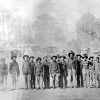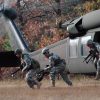calsfoundation@cals.org
Scout from Cassville, Missouri, to Cross Hollow
The scout from Cassville, Missouri, to Cross Hollow (Benton County) was undertaken in an attempt to capture Major William “Buck” Brown and his band of irregular cavalrymen as they destroyed telegraph lines connecting various Federal bases.
By the summer of 1864, the only telegraph lines in Arkansas connected Little Rock (Pulaski County) to Pine Bluff (Jefferson County) and DeValls Bluff (Prairie County), and Fort Smith (Sebastian County) to Van Buren (Crawford County) and sometimes Fayetteville (Washington County), while other lines linked Fayetteville to Union bases in Missouri. All of the telegraph lines were in constant danger of being cut by Confederate guerrillas operating in Arkansas and Missouri.
On June 7, 1864, Brigadier General John B. Sanborn ordered Lieutenant Colonel Hugh Cameron of the Second Arkansas Cavalry Regiment (US), commanding the post at Cassville, Missouri, to send a detachment of troopers under “a good officer” to ride to Cross Hollow (earlier the site of a Confederate camp) and Elm Springs (Washington and Benton counties) “and try to surprise and capture Buck Brown and his command,” as well as sending a team to “gather up the telegraph wire along the road and bring it to Cassville.”
Two days later, Major Jeremiah Hackett led a party of the Second Arkansas horsemen and some accompanying infantrymen out of Cassville, heading toward Arkansas. The start of the expedition was uneventful, and they camped about five miles from Cross Hollow on June 10, firing at a pair of bushwhackers, who escaped. They rode on to Fitzgerald Mountain in Washington County the next day and found that “the telegraph was completely destroyed for more than one-half mile.” When they returned to Cross Hollow to camp, they found the telegraph wire “cut in several places.”
They found more destruction the next day as they approached Sugar Creek, “where the wire was destroyed for more than one-quarter mile, poles dug up and insulators broken up.” After camping on Sugar Creek, Hackett led some of his cavalrymen to Packet’s Mills on Prairie Creek, where they found four guerrillas, “well mounted and armed,” who scattered at their approach. The scouts returned to the Wire Road at Pea Ridge (Benton County), where they rejoined the infantry and found two women, “Mrs. and Miss Gibson, engaged in an attempt to break the telegraph wire near the forks of the Bentonville [Benton County] road.” Taking them prisoner, the scouting expedition returned to Cassville on June 14.
While Hackett’s expedition failed to connect with Buck Brown’s guerrillas, they did succeed in finding significant damage to the telegraph lines in Washington and Benton counties and determined that bushwhackers were not the only ones responsible for the destruction. It is unknown what happened to the Gibson women.
For additional information:
Plum, William R. The Military Telegraph during the Civil War in the United States. Chicago: Jansen, McClurg and Co., 1882.
The War of the Rebellion: A Compilation of the Official Records of the Union and Confederate Armies, Series I, Vol. 34, part 1, pp. 993; part 4, p. 263. Washington DC: Government Printing Office, 1891.
Mark K. Christ
Central Arkansas Library System
 Civil War Timeline
Civil War Timeline Military
Military



Comments
No comments on this entry yet.